Abstract
For several decades, southern California experienced the worst ozone pollution ever reported. Peak ozone concentrations have, however, declined steadily since 1980. In this study, the structural injuries underlying ozone symptoms in needles of ponderosa pine (Pinus ponderosa Dougl. ex Laws.) collected in summer 2006 from one of the most polluted sites in the San Bernardino Mountains were investigated using serial sections examined by light and electron microscopy. Ozone-specific light-green diffuse mottling was observed in the current-year needles, whereas older foliage showed brownish mottling similar to winter fleck injury. Especially, within the outer layers of mesophyll, many markers of oxidative stress, typical for ozone, were observed in both apoplast and symplast. Altogether within cells of mottles, these markers were indicative of hypersensitive-like response, whereas degenerative structural changes were diagnosed in the surrounding mesophyll. Evidence of drought stress and frost injury to older needles was also detected. Hence, mottling injury appeared to be primarily caused by ozone stress, however, other environmental stressors also determined the symptom morphology and distribution, especially within the older foliage.







Similar content being viewed by others
References
Alvarez D, Laguna G, Rosas I (1998a) Macroscopic and microscopic symptoms in Abies religiosa exposed to ozone in a forest near Mexico City. Environ Pollut 103:251–259
Alvarez ME, Pennell RI, Meijer PJ, Ishikawa A, Dixon RA, Lamb C (1998b) Reactive oxygen intermediates mediate a systemic signal network in the establishment of plant immunity. Cell 92:773–784
Anttonen S, Karenlampi L (1996) Slightly elevated ozone exposure causes cell structural changes in needles and roots of Scots pine. Trees 10:207–217
Anttonen S, Herranen J, Peura P, Karenlampi L (1995) Fatty-acids and ultrastructure of ozone-exposed Aleppo pine (Pinus halepensis Mill) needles. Environ Pollut 87:235–242
Anttonen S, Sutinen ML, Heagle AS (1996) Ultrastructure and some plasma membrane characteristics of ozone-exposed loblolly pine needles. Physiol Plant 98:309–319
Arbaugh MJ, Miller PR, Carroll JJ, Takemoto B, Procter T (1998) Relationships of ozone exposure to pine injury in the Sierra Nevada and San Bernardino Mountains of California, USA. Environ Pollut 101:291–301
Arkley RJ (1981) Soil moisture use by mixed conifer forest in a summer-dry climate. Soil Sci Soc Am J 45:423–427
Bâesso Moura B, Ribeiro de Souza S, Segala Alves E (2011) Structural responses of Ipomea nil (L.) Roth ‘Scarlet O’Hara’ (Convolvulaceae) exposed to ozone. Acta Bot Brasilica 25:122–129
Baier M, Kandlbinder A, Golldack D, Dietz KJ (2005) Oxidative stress and ozone: perception, signalling and response. Plant Cell Environ 28:1012–1020
Bréhélin C, Kessler F, van Wijk KJ (2007) Plastoglobules: versatile lipoprotein particles in plastids. Trends Plant Sci 12:260–266
Brundrett MC, Kendrick B, Peterson CA (1991) Efficient lipid staining in plant material with sudan red 7B or fluoral yellow 088 in polyethylene glycol-glycerol. Biotech Histochem 66:111–116
Bussotti F, Agati G, Desotgiu R, Matteini P, Tani C (2005) Ozone foliar symptoms in woody plant species assessed with ultrastructural and fluorescence analysis. New Phytol 166:941–955
Bytnerowicz A, Fenn ME (1996) Nitrogen deposition in California forests: a review. Environ Pollut 92:127–146
Bytnerowicz A, Arbaugh A, Schilling S, Fraczek W, Alexander D, Dawson P (2007) Air pollution distribution patterns in the San Bernardino Mountains of southern California: a 40-year perspective. Sci World J 7:98–109
Bytnerowicz A, Arbaugh M, Schilling S, Fraczek W, Alexander D (2008) Ozone distribution and phytotoxic potential in mixed conifer forests of the San Bernardino Mountains, Southern California. Environ Pollut 155:398–408
Clark G (1981) Staining procedures, 4th edn. Williams & Wilkins, Baltimore
Coyne PI, Bingham GE (1982) Variation in photosynthesis and stomatal conductance in an ozone-stressed ponderosa pine stand—light response. For Sci 28:257–273
Dalstein L, Vas N (2005) Ozone concentrations and ozone-induced symptoms on coastal and alpine Mediterranean pines in southern France. Water Air Soil Pollut 160:181–195
Davis DD (1977) Response of ponderosa pine primary needles to separate and simultaneous ozone and PAN exposure. Plant Dis Rep 61:640–644
de Bauer MD, Hernandez-Tejeda T (2007) A review of ozone-induced effects on the forests of central Mexico. Environ Pollut 147:446–453
Diaz-de-Quijano M, Penuelas J, Ribas A (2009) Increasing interannual and altitudinal ozone mixing ratios in the Catalan Pyrenees. Atmos Environ 43:6049–6057
Díaz-de-Quijano M, Peñuelas J, Menard T, Vollenweider P (2011) Visible and microscopical ozone injury in mountain pine (Pinus mugo subsp. uncinata) foliage from the Catalan Pyrenees. International Conference Ozone, climate change and forests, 14–16 June 2011, Prague, Czech Republic. http://cost-fp0903.ipp.cnr.it/Downloads/Prague/BookAbstracts.pdf. Accessed 11 June 2012
Evans LS, Fitzgerald GA (1993) Histological effects of ozone on slash pine (Pinus elliotti var. densa). Environ Exp Bot 33:505–513
Evans LS, Leonard MR (1991) Histological determination of ozone injury symptoms of primary needles of giant sequoia (Sequoiadendron giganteum Bucch). New Phytol 117:557–564
Evans LS, Miller PR (1972a) Comparative needle anatomy and relative ozone sensitivity of four pine species. Can J Bot 50:1067–1071
Evans LS, Miller PR (1972b) Ozone damage to ponderosa pine—histological and histochemical appraisal. Am J Bot 59:297–304
Feder N, O’Brien TP (1968) Plant microtechnique: some principles and new methods. Am J Bot 55:123–142
Fenn ME, Jovan S, Yuan F, Geiser L, Meixner T, Gimeno BS (2008) Empirical and simulated critical loads for nitrogen deposition in California mixed conifer forests. Environ Pollut 155:492–511
Fink S (1999) Pathological and regenerative plant anatomy. Encyclopedia of plant anatomy, vol XIV/6. Gebrüder Bornträger, Berlin, Stuttgart
Flagler RB, Chappelka AH (1995) Growth response of southern pines to acidic precipitation and ozone. In: Fox S, Mickler RA (eds) Impact of air pollutants on southern pine forest. Ecological Studies 118. Springer, Berlin, pp 388–424
Foyer CH, Lelandais M, Kunert KJ (1994) Photooxidative stress in plants. Physiol Plant 92:696–717
Gahan PB (1984) Plant histochemistry and cytochemistry. Academic Press, London
Gerlach D (1984) Botanische Mikrotechnik, 3rd edn. Thieme Verlag, Stuttgart
Grulke NE (2003) The physiological basis of O3 injury assessment attributes in Sierran conifers. In: Bytnerowicz A, Arbaugh M, Alonso R (eds) Assessment of O3 distribution and its effects on Sierra Nevada ecosystems. Developments in Environmental Science 2. Elsevier, The Hague, pp 55–81
Grulke NE, Balduman L (1999) Deciduous conifers: high N deposition and O-3 exposure effects on growth and biomass allocation in ponderosa pine. Water Air Soil Pollut 116:235–248
Grulke NE, Lee EH (1997) Assessing visible ozone-induced foliar injury in ponderosa pine. Can J For Res 27:1658–1668
Grulke NE, Andersen CP, Fenn ME, Miller PR (1998) Ozone exposure and nitrogen deposition lowers root biomass of ponderosa pine in the San Bernardino Mountains, California. Environ Pollut 103:63–73
Grulke NE, Minnich RA, Paine TD, Seybold SJ, Chavez DJ, Fenn ME, Riggan PJ, Dunn A (2009) Air pollution increases forest susceptibility to wildfires: a case study in the San Bernardino Mountains in southern California. In: Bytnerowicz A, Arbaugh MJ, Riebau AR, Andersen C (eds) Wildland fires and air pollution. Developments in Environmental Science, vol 8. Elsevier, Amsterdam, pp 365–403
Günthardt-Goerg MS, Vollenweider P (2007) Linking stress with macroscopic and microscopic leaf response in trees: new diagnostic perspectives. Environ Pollut 147:88–467
Günthardt-Goerg MS, McQuattie CJ, Scheidegger C, Rhiner C, Matyssek R (1997) Ozone-induced cytochemical and ultrastructural changes in leaf mesophyll cell walls. Can J For Res 27:453–463
Hartmann G, Nienhaus F, Butin H (2007) Farbatlas Waldschäden. 3. Auflage. Diagnose von Baumkrankheiten. 3. Auflage. Eugen Ulmer KG, Stuttgart
Hermle S, Vollenweider P, McQuattie CJ, Matyssek R, Günthardt-Goerg MS (2007) Leaf responsiveness of field-grown Populus tremula and Salix viminalis to soil contamination by heavy metals and rainwater acidity. Tree Physiol 27:1517–1531
Holopainen T, Anttonen S, Palomaki V, Kainulainen P, Holopainen JK (1996) Needle ultrastructure and starch content in Scots pine and Norway spruce after ozone fumigation. Can J Bot 74:67–76
Iriti M, Faoro F (2008) Oxidative stress, the paradigm of ozone toxicity in plants and animals. Water Air Soil Pollut 187:285–301
Jones A (2000) Does the plant mitochondrion integrate cellular stress and regulate programmed cell death? Trends Plant Sci 5:225–230
Kainulainen P, Utriainen J, Holopainen JK, Oksanen J, Holopainen T (2000) Influence of elevated ozone and limited nitrogen availability on conifer seedlings in an open-air fumigation system: effects on growth, nutrient content, mycorrhiza, needle ultrastructure, starch and secondary compounds. Glob Change Biol 6:345–355
Kangasjarvi J, Jaspers P, Kollist H (2005) Signalling and cell death in ozone-exposed plants. Plant Cell Environ 28:1021–1036
Karnosky DF, Skelly JM, Percy KE, Chappelka AH (2007) Perspectives regarding 50 years of research on effects of tropospheric ozone air pollution on US forests. Environ Pollut 147:489–506
Kivimäenpää M, Sellden G, Sutinen S (2005) Ozone-induced changes in the chloroplast structure of conifer needles, and their use in ozone diagnostics. Environ Pollut 137:466–475
Kivimäenpää M, Sutinen S, Calatayud V, Sanz MJ (2010) Visible and microscopic needle alterations of mature Aleppo pine (Pinus halepensis) trees growing on an ozone gradient in eastern Spain. Tree Physiol 30:541–554
Levine A, Pennell RI, Alvarez ME, Palmer R, Lamb C (1996) Calcium-mediated apoptosis in a plant hypersensitive disease resistance response. Curr Biol 6:427–437
Matyssek R, Sandermann H (2003) Impact of ozone on trees: an ecophysiological perspective. Progress in Botany 64. Springer, Heidelberg, pp 349–404
McQuattie CJ, Schier GA (1993) Effect of ozone and aluminium on pitch pine (Pinus rigida) seedlings—needle ultrastructure. Can J For Res 23:1375–1387
Mikkelsen TN, Heide-Jorgensen HS (1996) Acceleration of leaf senescence in Fagus sylvatica L. by low levels of tropospheric ozone demonstrated by leaf colour, chlorophyll fluorescence and chloroplast ultrastructure. Trees 10:145–156
Miller PR, Evans LS (1974) Histopathology of oxidant injury and winter fleck injury on needles of western pines. Phytopathology 64:801–806
Miller PR, McBride JR (1999) Oxidant air pollution impacts in the montane forests of Southern California. Ecol Studies, vol 134. Springer, New York
Miller PR, Rechel J (1999) Temporal changes in crown condition indices, needle litterfall, and collateral needle injuries of ponderosa and Jeffrey pines. In: Miller PR, McBride JR (eds) Oxidant air pollution impacts in the montane forests of southern California: a case study of the San Bernardino Mountains. Ecol Stud 134. Springer, New York, pp 164–178
Miller PR, Taylor OC, Parmeter JR, Cardiff EA (1963) Ozone injury to foliage of Pinus ponderosa. Phytopathology 53:1072–1076
Miller PR, Arbaugh MJ, Temple PJ (1997) Ozone and its known and potential effects on forests in Western United States. In: Sandermann H Jr, Wellburn AR, Heath RL (eds) Forest decline and ozone. Ecol Stud 127. Springer, Berlin, pp 39–67
Munck L (1989) Fluorescence analysis in food. Longman Scientific and Technical, Harlow
Padgett PE, Parry SD, Bytnerowicz A, Heath RL (2009) Image analysis of epicuticular damage to foliage caused by dry deposition of the air pollutant nitric acid. J Environ Monit 11:63–74
Panek JA (2004) Ozone uptake, water loss and carbon exchange dynamics in annually drought-stressed Pinus ponderosa forests: measured trends and parameters for uptake modeling. Tree Physiol 24:277–290
Panek JA, Goldstein AH (2001) Response of stomatal conductance to drought in ponderosa pine: implications for carbon and ozone uptake. Tree Physiol 21:337–344
Polle A (1997) Defense against photooxidative damage in plants. In: Scandalios JG (ed) Oxidative stress and the molecular biology of antioxidant defenses. Cold Spring Harbor Laboratory Press, New York, pp 623–666
Richards BL Sr, Taylor OC, Edmunds GF Jr (1968) Ozone needle mottle of pine in southern California. J Air Pollut Control Assoc 18:73–77
Richter G (1993) Métabolisme des végétaux. Physiologie et Biochimie. Presses polytechniques et universitaires romandes, Lausanne
Richter Ch, Schweizer M (1997) Oxidative stress in mitochondria. In: Scandalios JG (ed) Oxidative stress and the molecular biology of antioxidant defenses. Cold Spring Harbor Laboratory Press, New York, pp 169–200
Sandermann H (1996) Ozone and plant health. Annu Rev Phytopathol 34:347–366
Sanz MJ, Calatayud V (2012) Ozone injury in European forest species. http://www.ozoneinjury.org. Accessed 11 June 2012
Sarkar SK, Howarth RE (1976) Specificity of the vanilin test for flavonoids. J Agric Food Chem 24:317–320
Seigler DS (1998) Plant secondary metabolism. Kluwer Academic Publishers, Boston
Soda C, Bussotti F, Grossoni P, Barnes J, Mori B, Tani C (2000) Impacts of urban levels of ozone on Pinus halepensis foliage. Environ Exp Bot 44:69–82
Stolte K (1996) Symptomology of ozone injury to pine foliage. In: Miller P, Stolte K, Duriscoe D (eds) General Technical Report PSW-GTR-155-Web. http://www.fs.fed.us/psw/publications/documents/gtr-155/publisher.html. Accessed 11 June 2012
Sutinen S (1986) Ultrastructure of mesophyll-cells in and near necrotic spots on otherwise green needles of Norway spruce. Eur J For Pathol 16:379–384
Sutinen S, Skarby L, Wallin G, Sellden G (1990) Long-term exposure of Norway spruce, Picea-Abies (L) Karst, to ozone in open-top chambers. 2. Effects on the ultrastructure of needles. New Phytol 115:345–355
Takemoto BK, Bytnerowicz A, Fenn ME (2001) Current and future effects of ozone and atmospheric nitrogen deposition on California’s mixed conifer forests. For Ecol Manage 144:159–173
Tevini M, Steinmüller D (1985) Composition and function of plastoglobuli. Planta 163:91–96
Utriainen J, Holopainen T (1998) Ultrastructural and growth responses of young Scots pine seedlings (Pinus sylvestris) to increasing carbon dioxide and ozone concentrations. Chemosphere 36:795–800
Vollenweider P, Günthardt-Goerg MS (2006) Diagnosis of abiotic and biotic stress factors using the visible symptoms in foliage. Environ Pollut 140:562–571
Vollenweider P, Ottiger M, Günthardt-Goerg MS (2003a) Validation of leaf ozone symptoms in natural vegetation using microscopical methods. Environ Pollut 124:101–118
Vollenweider P, Woodkock H, Kelty MJ, Hofer R-M (2003b) Reduction of stem growth and site dependency of leaf injury in Massachusetts black cherries exhibiting ozone symptoms. Environ Pollut 125:467–480
Walter H, Lieth H (1967) Klimadiagram-Weltatlas. VEB Gustav Fischer Verlag, Jena
Weis KG, Polito VS, Labavitch JM (1988) Microfluorometry of pectic materials in the dehiscence zone of almond (Prunus dulcis [Mill] DA Webb) fruits. J Histochem Cytochem 36:41–1037
Wetzel S, Demmers C, Greenwood JS (1989) Spherical organelles, analogous to seed protein bodies, fluctuate seasonally in parenchymatous cells of hardwoods. Can J Bot 67:3439–3445
Yamasaki H, Sakihama Y, Ikehara N (1997) Flavonoid-peroxidase reaction as a detoxification mechanism of plant cells against H2O2. Plant Physiol 115:1405–1412
Acknowledgments
The authors gratefully acknowledge the technical support of Susan Schilling for the air pollution data calculation and mapping, of Lara Pfister for light microscopy and of the Center for Microscopy and Image Analysis of the University of Zürich for electron microscopy.
Author information
Authors and Affiliations
Corresponding author
Additional information
Communicated by R. Matyssek.
Rights and permissions
About this article
Cite this article
Vollenweider, P., Fenn, M.E., Menard, T. et al. Structural injury underlying mottling in ponderosa pine needles exposed to ambient ozone concentrations in the San Bernardino Mountains near Los Angeles, California. Trees 27, 895–911 (2013). https://doi.org/10.1007/s00468-013-0843-7
Received:
Revised:
Accepted:
Published:
Issue Date:
DOI: https://doi.org/10.1007/s00468-013-0843-7




